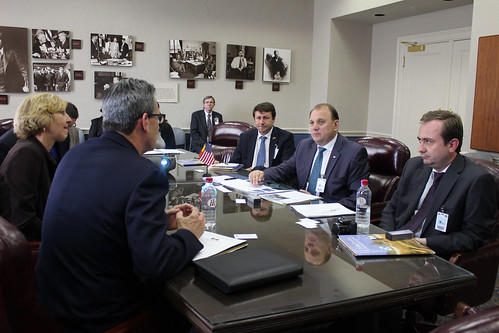
Moldova’s minister of agriculture and food industry, Vasile Bumacov, recently visited with USDA’s Natural Resources Conservation Service (NRCS) to learn more about no-till and minimum-till systems – and how the agency supports farmers wanting to implement them.
NRCS briefed Minister Bumacov on technical and financial assistance programs that promote the use, by American farmers, of no-till and minimum-till systems, where crops are grown with little soil disturbance and the soil is kept covered with crop residue to conserve soil, water and energy. The assistance from NRCS provides U.S. farmers guidance and funding in putting these systems to work.
“In addition to the conservation benefits, no-till and minimum-till systems add to the overall energy efficiency of the entire farming operation, saving fuel and labor,” said Terrell Erickson, NRCS’ director of Ecological Sciences Division and meeting host.
Conservation methods like continuous no-till or minimum-till, crop rotation and cover crops are keys to building healthy soils. At the same time, these methods minimize potential problems, including soil erosion, wind erosion, degradation of soil and energy consumption. NRCS promotes a wide variety of cropping practices as part of a systems-approach to sustaining and improving natural resources.
“The Minister expressed his interest and support of no-till and minimum-till systems,” said Erickson on the outcome of the meeting.
Moldova’s economy relies heavily on agriculture, but soil erosion is a serious problem and has caused declines in harvests. Three-fourths of Moldova’s land is used for agriculture.
With international support from groups like World Bank, USAID and Global Environmental Facility, Moldova is working to strengthen agricultural lands, including improving topsoil and unstable ground. Bumacov and NRCS’ meeting highlights a shared and continued priority to bring positive environmental changes through conservation practices.
Moldova is a landlocked country in Eastern Europe northeast of Romania. The best-known product and number one export from Moldova is wine. Fruits and vegetables – especially apples – are among the top five of Moldovan agriculture exports. The agriculture and food processing sector make up about 40 percent of the country’s gross domestic product.
NRCS has a long history with partners in other countries starting with the early days of the agency. Over the years, NRCS has gained access to technology developed in other countries and obtained data that increases understanding of natural resources management. NRCS has also provided technical assistance to other countries that vastly improved natural resources conservation, which has aided in the transition from subsistence to sustainable food security.
